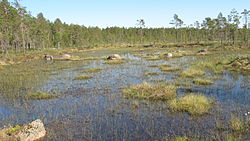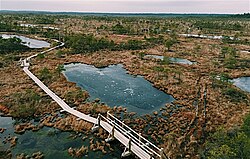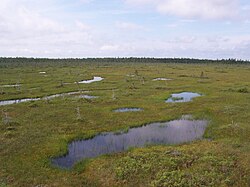Bog
A bog is a wetland where peat builds up. Peat is layers of dead plant material—often mosses, in most cases, Sphagnum moss.[1] It is one of the four main types of wetlands. Other names for bogs include mire, quagmire and muskeg.
Frequently, as the illustration on the right shows, they are covered in Ericaceous shrubs rooted in the Sphagnum moss and peat. The gradual buildup of decayed plant material in a bog forms a carbon sink.[2]
Bogs occur where the water at the ground surface is acidic and low in nutrients. In some cases, the water is entirely from precipitation, in which case they are (rain-fed). Water flowing out of bogs has a characteristic brown colour, which comes from dissolved peat tannins.
In general, the low fertility and cool climate results in relatively slow plant growth, but decay is even slower because of the saturated soil. So, the amount of peat increases. Large areas of landscape can be covered many meters deep in peat.[1][3] Bogs have a distinctive group of plant and animal species and are of high importance for biodiversity, particularly in landscapes that are otherwise settled and farmed.
World's largest peat bog
The world's largest peat bog is in the Congo (Brazzaville).[4] It is as big as England. The bog covers between 100,000 and 200,000 square kilometres (40,000 to 80,000 sq miles), with the peat layer reaching up to 7m (23) beneath the ground. It holds billions of tonnes of partially decayed vegetation.[4]
Bog Media
A bog in Lauhanvuori National Park, Isojoki, Finland
Peat bog and peat to dry, L'Isle-aux-Coudres, Quebec, Canada, 1976
Drone video of Kakerdaja bog in Estonia (September 2021)
A raised bog in Ķemeri National Park, Jūrmala, Latvia, formed approximately 10,000 years ago in the postglacial period and now a tourist attraction.
An expanse of wet Sphagnum bog in Frontenac National Park, Quebec, Canada. Spruce trees can be seen on a forested ridge in the background.
Many species of evergreen shrub are found in bogs, such as Labrador tea.
References
- ↑ 1.0 1.1 Keddy P.A. 2010. Wetland ecology: principles and conservation. 2nd ed, Cambridge University Press.
- ↑ British soil is battlefield over peat, for bogs' sake. October 6, 2012. https://www.nytimes.com/2012/10/07/science/earth/british-gardeners-battle-over-peat-for-bogs-sake.html. Retrieved October 7, 2012.
- ↑ Gorham E. 1957. The development of peatlands. Quarterly Review of Biology. 32, 145–166.
- ↑ 4.0 4.1 Morelle, Rebecca 2014. Colossal peat bog discovered in Congo. BBC News Science & Environment. [1]









